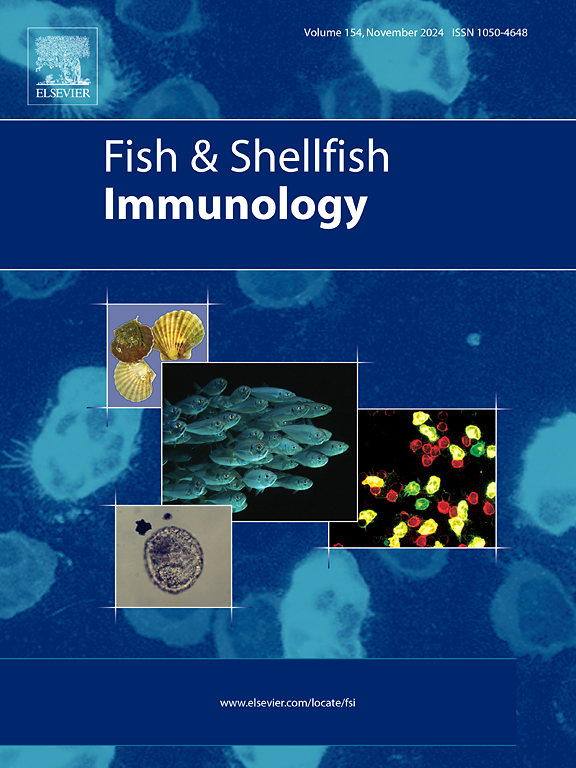Kinetics of viral hemorrhagic septicemia virus (VHSV) and immune response in olive flounder (Paralichthys olivaceus) at altered temperature
IF 4.1
2区 农林科学
Q1 FISHERIES
引用次数: 0
Abstract
Viral hemorrhagic septicemia virus (VHSV) is a pathogen that causes hemorrhagic septicemia in olive flounder at water temperatures below 15 °C, leading to symptoms such as abdominal swelling due to ascites and muscle hemorrhaging, and in severe cases, mortality. In this study, we investigated the proliferation of NCCs, the transcriptional analysis of CD4 and CD8, and the expression of pro-inflammatory cytokines (IL-1β, IL6, TNFα) and the cytokines (IL12, IL15, IFN-1β, IFNγ) involved in cytotoxic cell activation in the kidney of olive flounder during VHSV infection at suboptimal temperature (17 °C) and following a shift to optimal temperature (10 °C). Following viral infection, the population of NCCs and CD8 gene expression steadily increased. Meanwhile, IL12, IL15, and IFN-1β levels exhibited an early surge, reaching their peak within 1–2 days post-challenge at 17 °C. Notably, in olive flounder that were re-challenged with VHSV at 10 °C after an initial challenge at 17 °C, there was a rapid and robust expansion of NCCs and increased CD4 and CD8 gene expression, demonstrating the mounting of immune memory by NCCs and an efficient adaptive immune response from CD4+ and CD8+ T cells against VHSV infection.
橄榄鲽(Paralichthys olivaceus)在改变温度条件下的病毒性出血性败血症病毒(VHSV)动力学和免疫反应。
病毒性出血性败血症病毒(VHSV)是一种病原体,在水温低于15 °C时会引起橄榄鲽出血性败血症,导致腹水引起的腹部肿胀和肌肉出血等症状,严重时会导致死亡。在这项研究中,我们调查了橄榄鲽在次优温度(17 °C)下感染 VHSV 和转入最适温度(10 °C)后肾脏中 NCCs 的增殖、CD4 和 CD8 的转录分析、促炎细胞因子(IL-1β、IL6、TNFα)和参与细胞毒性细胞活化的细胞因子(IL12、IL15、IFN-1β、IFNγ)的表达。病毒感染后,NCCs 数量和 CD8 基因表达量稳步增加。与此同时,IL12、IL15 和 IFN-1β 的水平也出现了早期激增,在 17 °C条件下,在病毒感染后 1-2 天内达到峰值。值得注意的是,橄榄鲽在 17 °C首次受到 VHSV 病毒感染后,在 10 °C再次受到 VHSV 病毒感染,NCCs 快速而稳健地扩增,CD4 和 CD8 基因表达增加,这表明 NCCs 形成了免疫记忆,CD4+ 和 CD8+ T 细胞对 VHSV 病毒感染做出了有效的适应性免疫反应。
本文章由计算机程序翻译,如有差异,请以英文原文为准。
求助全文
约1分钟内获得全文
求助全文
来源期刊

Fish & shellfish immunology
农林科学-海洋与淡水生物学
CiteScore
7.50
自引率
19.10%
发文量
750
审稿时长
68 days
期刊介绍:
Fish and Shellfish Immunology rapidly publishes high-quality, peer-refereed contributions in the expanding fields of fish and shellfish immunology. It presents studies on the basic mechanisms of both the specific and non-specific defense systems, the cells, tissues, and humoral factors involved, their dependence on environmental and intrinsic factors, response to pathogens, response to vaccination, and applied studies on the development of specific vaccines for use in the aquaculture industry.
 求助内容:
求助内容: 应助结果提醒方式:
应助结果提醒方式:


